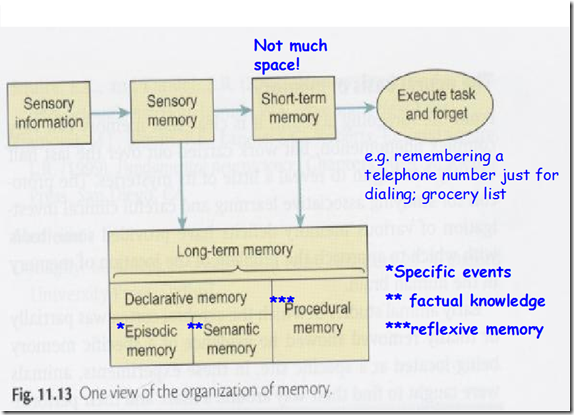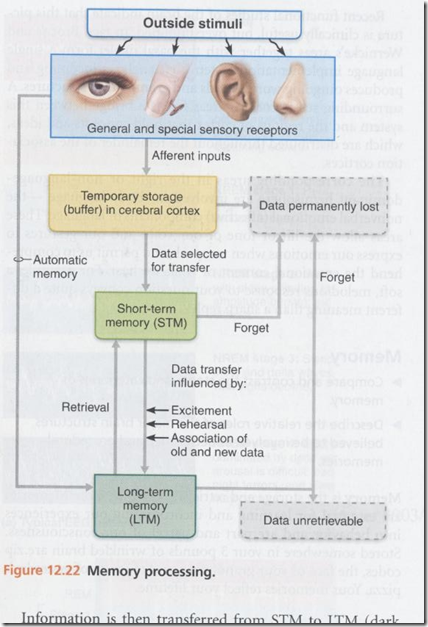Integrated function
Cerebral cortex
- Voluntary movement
- Language
- Language area= left hemisphere
- Wernicke’s area
- superior & posterior portion of the temporal lobe
- LANGUAGE COMPREHENSION
- comprehension of written words, sounds, signs
- Wernicke’s aphasia
- can speak, but makes no sense
- eg. says “chicken’ when pictures of chairs
- Broca’s area
- Frontal lobe
- LANGUAGE EXPRESSION
- speak/write word
- Broca’s aphasia
- can comprehend, but cannot speak
- Can identify trees, chairs etc but cannot say it
- Emotions & motivation
- 4 components
- Cognition
- Affect (feelings)
- Conation (urge to take action)
- Physical changes (BP, HR changes, sweating)
- Inputs from
- Memory
- Special senses
- Relayed in
- Limbic cortex
- hypothalamus
- Anger & Aggression
- Cerebral cortex
- limbic system
- hypothalamus
- Fear & Anxiety
- Amygdala
- Motivation
- impulse that drives our action
- Physiological changes/pleasure derived from stimulation of “pleasure centres” which activate dopaminergic neurones
- Reward/ Approach system
- Cocaine appears to act here
- Avoidance associated with lateral portion of posterior hypothalamus, dorsal midbrain & entorhinal cortex
- punishment/ avoidance system
- Sleep
- Learning & Memory
- Learning: acquisition of new memory/skills
- Memory: retention of information/skills/thoughts
- 2 types of learning
- Associative
- Connections between two or more stimuli
- eg. Conditioned Reflexes (Pavlov’s dogs)/use of mnemonics/learning hands-on that fire is hot
- Non-associative
- Repetition
- Habituation
- reduced responses to repeated stimuli
- Sensitisation
- increased response
- Habituation/ sensitisation
- depends on how important it is to us
- eg. a mother sleeps through loud noises but wakes up at her baby’s cry
- 2 types of memories
- Non-declarative, implicit, reflexic
- Memory of learned skills ( & habits)
- eg. riding a bicycle/route to home
- Simple classical conditioning
- Priming
- Stored in several areas including
- Cerebellum
- Basal nuclei
- Pons
- Once learnt, do not require a conscious effort of recall
- Declarative, explicit
- Memory of learned experiences
- facts or figures
- eg. recite the alphabet, remember birthdays
- Short-term memory
- consolidated into long-term memory
- in hippocampus (encoding in HIPPOCAMPUS)
- Long-term memory stored in
- various parts of the neocortex
- stimulation of implanted electrodes plays back memories
- Amygdala add emotional colour to memories
- Areas of the brain associated with memory
- Working/short term memory
- frontal lobe
- Long term memory
- hippocampus
- Habits & skills
- cerebellum
- basal nuclei
_____________________________________________________________________
Cerebral lobes
- Damage to frontal lobe
- reduced anxiety
- personality changes
- unpredictable
- uninhibited social behaviour
- epilepsy
- Damage to parietal lobe
- Agnosia
- Loss of cognition
- No sensory deficit
- but fails to recognise objects
- Visual Agnosia
- can recognise through touch but not by vision
- Astereognosis
- cannot recognise by touch
- Apraxia
- loss of ability to perform specific purposeful movements
- cannot wave goodbye, but can perform that act spontaneously
- Constructional apraxia
- Failure to use everyday objects appropriately or construct/draw a simple object
- Kinetic apraxia
- Deficit in the control of movements of one hand caused by damage to the premotor area of the frontal lobe of the opposite side
- Neglect syndrome
- stroke in posterior region of right hemisphere
- cannot perform left hand side functions
Limbic system (Rhinencephalon)
- Rim of cortical tissue around the hilum of the cerebral cortex and associated deep structures (amygdala, hippocampus & septal nuclei)
- Plays a role in
- ANS functions
- Olfaction
- Feeding behaviour
- Sexual behaviour
- Rage & fear
- Motivation
- Principal connections of limbic system
- Hippocampal system
- hippocampus-fornix-mamilary body- ant.thalamic nuclei- cingulate cortex- hippocampus
- Olfactory & amygdaloid connections
Memory
Encoding (of memory)
- Not known how
- Repetition
- How important it is to you also counts
- eg. you get married only once, but remember the date
- Short -term memory
- stored in the frontal lobe but only temporarily (a few seconds to a few minutes)
- the information needs to be consolidated into long-term memory
- because the space is limited
- Long-term memory
- resides in the hippocampus
- lasts years/ lifetime
- Forgetting is an essential part of learning
- Cases of herpes simplex attacking the brain
- hippocampus
- Brain surgery performed to relieve epileptic seizures
- very short memory span
- but can recall long-term memories
Long term potentiation (LTP)
- Because of the property of plasticity
- ability to alter the anatomy and function in response to changes in its activity patterns
- new neurons are produced in the areas involved in memory
- Long term potentiation
- repeated stimulation results in increased strength of that synaptic connection
- increased number of EPSPs
- Brief patterned stimulation leads to a long-lasting increase in the efficacy of synaptic transmission lasting minutes to hours!
- Memory improves with repetition
- First seen in hippocampus (encoding)
- Consolidation of long-term memory
Conditioned reflexes
- Reflex response to a stimulus that previously elicited no response
- by repeatedly pairing the stimulus with another stimulus that normally produces the response
- Eg. Salivation (response) occurs when meat is placed in the mouth
- Unconditioned stimulus (US)
- Ringing of bell which normally does not cause salivation
- conditioned stimulus (CS)
- before placing the meat in the mouth
- Repeatedly doing this results in salivation when the bell is rung
- US combined with pleasant or unpleasant effect helps to establish the conditioned reflex
- Positive & Negative reinforcement
- If the CS is presented repeatedly without US
- the conditioned reflex eventually dies out
- Extinction/Internal inhibiton
- Operant conditioning
- taught to operate the environment to obtain a reward or avoid punishment
- CS is a light or other signal that alerts the animal to perform a task
- US is the pleasant or unpleasant event
- eg. light- electric shock
- can be prevented by pressing a bar
Circadian rhythm
- Rhythms < 24 hours- ultradian
- e.g. heart beat, respiratory cycle
- Rhythms > 24 h – infradian
- e.g. menstrual cycle, gestation
- Peripheral clocks/rhythm generators
- exist in many tissues
- but the ‘master clock’ is the suprachiasmatic nucleus (SCN)
- Circannual rhythms
- yearly rhythm
- e.g. breeding, hibernation, migration
- Endogenous Rhythms
- dictated by the “Biological Clock”
- suprachiasmatic nucleus (SCN)
- But influenced by exogenous cues
- Entrainment by social and physical cues
- Pineal gland produces melatonin in the dark
- drowsiness, loss of alertness
- Useful to minimise
- Jet lag
- Seasonal Affective Disorder in winter






